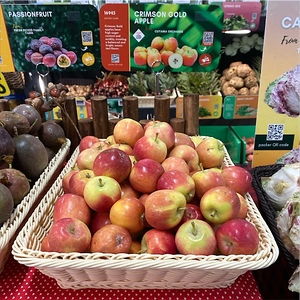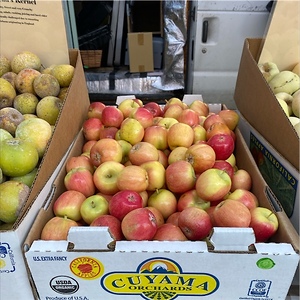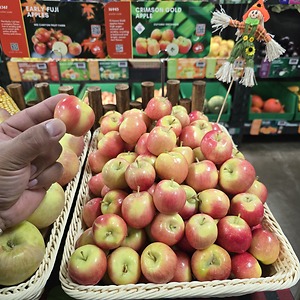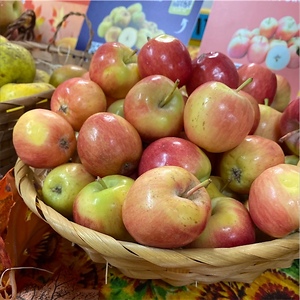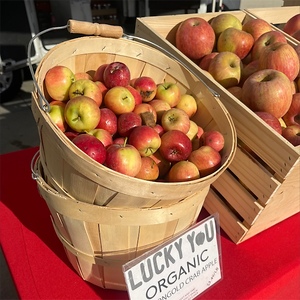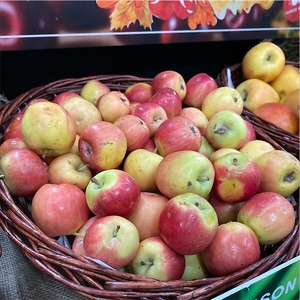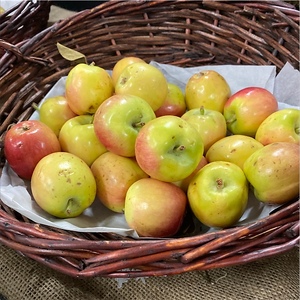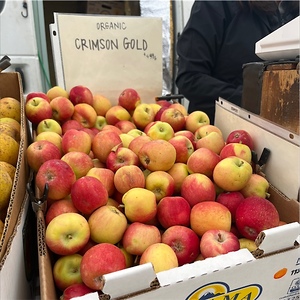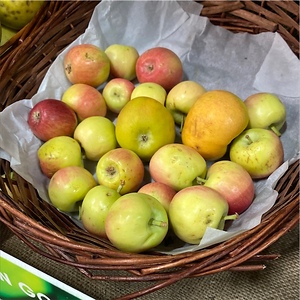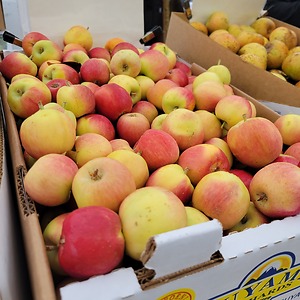

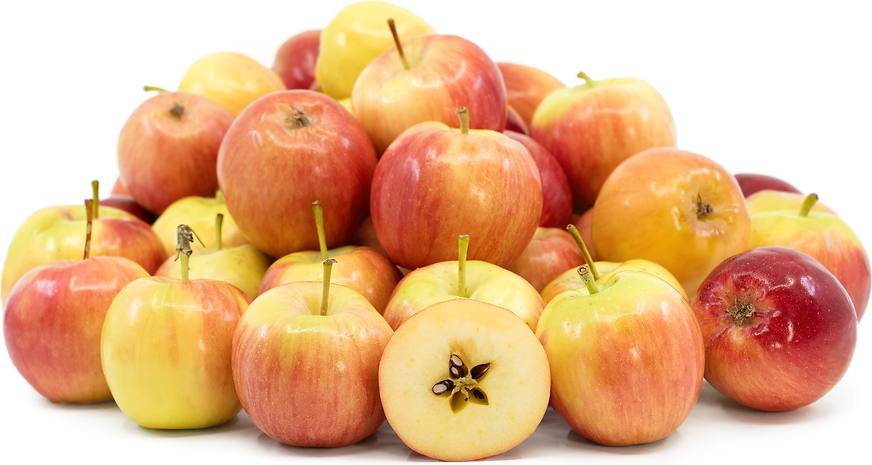
Crimson Gold Apples
Estimated Inventory, 13 lbs : 0
This item was last sold on : 02/07/25
Description/Taste
Crimson Gold apples are larger than most crab apple varieties, averaging 4 to 5 centimeters in diameter, and are a hybrid cultivar that showcases a round, oblate, to conical appearance. The apple’s skin is smooth, taut, and thin with a faint sheen, and some fruits may display a brown freckled surface, a cosmetic trait caused by specific weather conditions. The skin also has a yellow-green base, eventually turning golden yellow, covered in patches of dark red, ruby-toned blush, and a faint bloom. The red blush will expand as the fruits mature, almost becoming solid red with a hint of yellow peeking out around the stem cavity. Underneath the surface, the cream-colored to white flesh is firm, semi-coarse, and aqueous, showcasing a crisp, crunchy consistency, fracturing into large chunks when bitten. The flesh also encases a central fibrous cavity filled with tiny black-brown seeds. Crimson Gold apples have high sugar content and acidity, creating a balanced and bright, sweet-tart flavor with subtle notes of fruity spice.
Seasons/Availability
Crimson Gold apples are available in the late fall through winter.
Current Facts
Crimson Gold apples, botanically a part of the Malus genus, are a crab apple hybrid belonging to the Rutaceae family. The apples were released in the mid-20th century and were created by famed apple breeder Albert Etter in California. Crimson Gold apples were a part of a focused project of Etter’s to develop hybrid apples derived from a crab apple parentage. Historically, crab apples were notorious for their sour flavor, and Etter sought to create new hybrid varieties that contained high sugar content and low astringency for a sweet and tangy taste. Since their creation, Crimson Gold apples have remained a rare variety, once almost being lost forever due to a case of mistaken identity. The sweet-tart apples are not commercially cultivated and are primarily grown through specialty orchards that highlight and preserve unusual varieties. Apple enthusiasts also seek out the variety for fresh eating, baked preparations, and cider making. It is important to note the Crimson Gold apples should not be confused with a variety of apple known as Crimson Gold apples originating in the Czech Republic. This variety is a medium to large apple sometimes labeled as Crimson® Gold and Svatava and is a sweet-tart dessert cultivar.
Nutritional Value
Crimson Gold apples are a source of fiber to regulate the digestive tract and potassium to balance fluid levels within the body. The apples also contain some vitamin C to strengthen the immune system while reducing inflammation, vitamin A to maintain healthy organ functioning, and provide other nutrients, including boron, magnesium, zinc, phosphorus, calcium, and iron.
Applications
Crimson Gold apples have a sweet-tart flavor well suited for fresh and cooked preparations. The apples can be consumed straight, out of hand, or chopped and added to green salads, slaws, and fruit bowls. Crimson Gold apples also provide a satisfying crunch when layered into sandwiches, served with cheeses, or dipped in nut butter as a snack. In addition to fresh preparations, Crimson Gold apples hold their shape well when baked or poached, becoming a favored crab apple hybrid for crisps, pies, cakes, tarts, and other pastries. The apples can also be poached in syrup as a rich dessert, sauteed in browned butter, sugar, and spices, or simmered into jelly, jam, or chutney. Beyond culinary preparations, Crimson Gold apples are frequently pressed into juice and used to enhance ciders, providing a complex blend of bright, sweet, and tangy flavors. Crimson Gold apples pair well with herbs such as rosemary, dill, thyme, and parsley, nuts including almonds, pecans, pistachios, and walnuts, meats such as bacon, sausage, poultry, and smoke fish, vanilla, brown sugar, caramel, and spices such as cinnamon, nutmeg, cloves, and ginger. Whole, unwashed Crimson Gold apples will keep 1 to 4 weeks when stored in a plastic bag and kept in the refrigerator’s crisper drawer. The apples can also be frozen for extended use.
Ethnic/Cultural Info
Crimson Gold apples were one of the last apple varieties created by Albert Etter in the 1930s before his passing in 1950. Etter valued the hybrid for its balanced, sharp flavor and ability to hold its shape well in cooking, two traits that he felt described the originality of the variety. Despite Etter’s promotion of the apples, mentioning the variety’s cooking ability to California Nursery Company’s owner George C. Roeding, Crimson Gold apples fell into obscurity for many years due to mislabeling. Legend has it that Crimson Gold apples were rediscovered and saved from extinction by using Etter’s favorite fact about the variety- that Crimson Gold apples can be boiled for extended periods without breaking down. Greenmantle Nursery used this trick when they found a single branch of Crimson Gold apples growing on a multi-grafted test tree in Etter’s orchard in the 1970s. The branch was labeled with a small metal plaque, almost unseen due to its tarnish, but once it was noticed, the branch was monitored until it began producing fruit. The apples were boiled for several hours and remained intact, signaling to the nursery that they had finally rediscovered a true strain of Crimson Gold apples.
Geography/History
Crimson Gold apples were developed by apple breeder Albert Etter in the 1930s in his orchard in Humbolt County, California. Etter initially named the variety Little Rosybloom and partnered with the California Nursery Company to introduce the crab apple hybrid to the public in 1945 through their catalog. The California Nursery Company introduced six of Etter’s creations, and Crimson Gold apples were labeled as a hybrid, produced from an unknown parentage, believed by experts to have a crab apple ancestry. Etter died soon after the apple’s release in 1950, and despite his efforts, the fruit’s patent paperwork was never finalized, leading the variety to remain unprotected. After Etter’s passing, Crimson Gold apples were mistakenly mislabeled under the ownership of the California Nursery Company, leading several wickson crab apples to be propagated and distributed as Crimson Gold apples. There were also several wickson crab apple samples sent to the United States Germplasm Repository in Geneva, New York that were distributed as Crimson Gold, contributing to the confusion. Wickson crab apples are known for their sour flavor, while Crimson Gold apples were favored for their sweet-tart taste, causing the variety to earn an unfavorable reputation when the apples were being mislabeled. True Crimson Gold apples were eventually identified in the 1970s, and the variety was reintroduced to the market. Today Crimson Gold apples are cultivated on a small-scale through specialty growers in the United States, with the majority of orchards being found in California. The variety is also grown in home gardens throughout the United States and through a few farms in Africa. When in season, Crimson Gold apples are found through farm stands, farmer’s markets, and select distributors.
Recipe Ideas
Recipes that include Crimson Gold Apples. One



